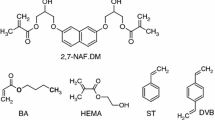Abstract
Using thermal volatilization analysis with differential condensation of volatile products, with film samples on flat-bottomed silica glass reaction tubes to permit measurements of UV spectra of partly degraded polymer, the thermal stability, the types of volatile products and the development of conjugation in the involatile residue have been compared for poly(vinyl chloride), polychloroprene, poly(vinyl acetate) and vinyl acetate/ethylene copolymers, poly(vinyl formate) and poly(vinyl alcohol). All undergo a side-group elimination reaction at lower temperatures, and polyene breakdown occurs in all the samples between 400 and 500°. The longest polyene sequences are formed by PVC. All the polymers except PVC show some complexity of products in the elimination reaction.
Résumé
L'emploi de la méthode d'analyse par volatilisation thermique avec condensation différentielle des produits volatils, sur des échantillons en film sur tubes de réaction en verresilice à fond plat permet l'examen des spectres ultraviolets des polymères partiellement dégradés et l'étude de la stabilité thermique, outre l'identification des constituants volatils. On a comparé le développement de la conjugaison dans le résidu non-volatil pour les polychlorure de vinyle, polychloroprène, polyacétate de vinyle et les copolymères acétate de vinyle/éthylène, polyformiate de vinyle et polyalcool vinylique. Dans chaque cas, on a observé une réaction d'élimination du groupe latéral à basse température et rupture du polyène entre 400 et 500°. Les plus longues séquences ont été formées dans le cas du PCV. Tous les polymères, excepté le PCV, montrent une certaine complexité de produits dans la réaction d'élimination.
Zusammenfassung
Die Anwendung der thermischen Verdampfungsanalyse durch Differentialkondensation der flüchtigen Produkte an Filmproben in flachen Quarzglasreaktionsrohren gestattet die Ermittlung der UV-Spektren von teilweise degradierten Polymeren sowie Aussagen über die thermische Stabilität und Types des flüchtigen Produktes. Die Bindungen in dem nichtflüchtigen Rest wurden untersucht und im Falle der Copolymere Poly(vinylchlorid), Polychloropren, Poly(vinylacetat) und Vinylacetat/Äthylen, weiterhin Poly/vinylformat und Poly/vinylalkohol verglichen. Alle erleiden eine Eliminierungsreaktion an der Seitengruppe bei niedrigeren Temperaturen und Polyenabspaltung zwischen 400 und 500°. Die längsten Polyensequenzen werden durch PVC gebildet. Abgesehen vom PVC zeigten alle übrigen Polymere eine gewisse Komplexität in der Eliminierungsreaktion.
Резюме
Проведены анализы те рмического испарени я полимеров с дифферен циальной конденсацией летйчи х продуктов. Использо вались образцы тонкого слоя (пленка), помещенные в плоскод онную кварцевую труб ку, что дало возможность исследо вать УФспектр частично распавшихс я полимеров, термоста бильность, состав летучих чподу ктов и образование конюга ции в нелетучем остат ке. Результаты сравнива лись для поливинилхл орида, полихлоропрена, поли винилацетат — и винилацетат-этилено вых сополимеров, поливинил — формиата и поливинилового спи рта. Каждый из них подвергается р еакции отщепления боковых г рупп при низкой темпе ратуре; расщепление полиена происходит во всех образцах в обл асти температур 400–500°. Б олее длинные ряды полиено в образуются в суйчае ПВЦ. При реакц ии расщепления все по лимеры, кроме ПВЦ, обнаружива ют некоторую сложность состава продуктов ра спада.
Similar content being viewed by others
References
I. C. McNeill, Europ. Polym. J., 3 (1967) 409.
I. C. McNeill andD. Neil, in Thermal Analysis, Vol. 1., p. 353,R. F. Schwenker andP. D. Garn (Eds.) Academic Press, New-York, 1969.
I. C. McNeill, ibid., p. 417.
I. C. McNeill, Europ. Polym. J., 6 (1970) 373.
I. C. McNeill, Europ. Polym. J., 4 (1968) 21.
R. McGuchan andI. C. McNeill, J. Polym. Sci., Part A 1, 6 (1968) 205.
N. Grassie, I. C. McNeill andI. Cooke, J. Appl. Polym. Sci., 12 (1968) 831.
I. C. McNeill andD. Neil, Makromol. Chem., 117 (1968) 265.
I. C.McNeill and D.Neil, Europ. Polym. J., in press.
I. C.McNeill and D.Neil, Europ. Polym. J., in press.
N.Grassie, I. F.McLaren and I. C.McNeill, Europ. Polym. J., in press.
N.Grassie and B. J. D.Torrance, J. Polym. Sci., Part A 1, in press.
N. Grassie andI. G. Meldrum, Europ. Polym. J., 4 (1968) 571.
M. C. McGaugh andS. Kottle, J. Polym. Sci., Part B, 5 (1967) 719.
M. C. McGaugh andS. Kottle, J. Appl. Polym. Sci., 12 (1968) 1961.
P. H. Johnson andR. L. Bebb, Ind. Eng. Chem., 41 (1949) 1577.
K. Fujii, S. Imoto, J. Ukida andM. Matsumoto, Kobunshi Kogaku, 19 (1962) 210, 581.
M. Thallmaier andD. Braun, Makromol. Chem., 108 (1967) 241.
W. C. Geddes, Europ. Polym. J., 3 (1967) 733.
A. Roedig, G. Voss andE. Kuchinke, Ann. der Chemie, 580 (1953) 30.
A. Roedig andK. Kiepert, Ann. der Chemie, 593 (1955) 63.
N. Grassie, Trans. Farad. Soc., 48 (1952) 379, 49 (1953) 835.
A. Servotte andV. Desreux, J. Polym. Sci., Part C, 22 (1968) 367.
P.Nayler and M. C.Whiting, J. Chem. Soc., 1967, 3037.
H. Futama andH. Tanaka, J. Phys. Soc. Japan, 12 (1957) 433.
B. Kaesche-Krischer andH. J. Heinreich, Chemie. Ing. Techn., 32 (1960) 598.
B. Duncalf andA. S. Dunn, J. Polym. Sci., Part C, 16 (1967) 1167.
C. E. Schildknecht, Vinyl and Related Polymers, Wiley, New York, 1952, p. 349.
J. B. Gilbert andJ. J. Kipling, Fuel, 41 (1962) 249.
M. Matsumoto, K. Imai andY. Kazusa, J. Polym. Sci., 28 (1958) 427.
Author information
Authors and Affiliations
Additional information
One of the authors (D.L.G.) thanks the Science Research Council for the award of a studentship. Some of the experiments with PVF were carried out by Mr. A. Jamieson. Differential condensation TVA curves were obtained by Mr. R. G. Perrett.
Rights and permissions
About this article
Cite this article
Gardner, D.L., McNeill, I.C. Investigations of thermal elimination reactions of polymers by thermal volatilization analysis and ultraviolet spectroscopy. Journal of Thermal Analysis 1, 389–402 (1969). https://doi.org/10.1007/BF01983081
Received:
Issue Date:
DOI: https://doi.org/10.1007/BF01983081




